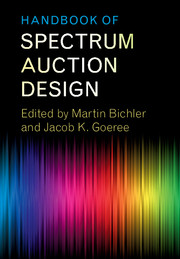Book contents
- Frontmatter
- Contents
- List of Contributors
- Preface
- List of Papers
- Part I The Simultaneous Multiple-Round Auction
- Part II The Combinatorial Clock Auction Designs
- Part III Alternative Auction Designs
- 18 A Combinatorial Auction Mechanism for Airport Time Slot Allocation
- 19 A New and Improved Design for Multi-Object Iterative Auctions
- 20 Hierarchical Package Bidding: A Paper & Pencil Combinatorial Auction
- 21 Assignment Messages and Exchanges
- 22 The Product-Mix Auction: A New Auction Design for Differentiated Goods
- 23 The Continuous Combinatorial Auction Architecture
- 24 Coalition-based Pricing in Ascending Combinatorial Auctions
- Part IV Experimental Comparisons of Auction Designs
- Part V The Bidders’ Perspective
- Part VI Secondary Markets and Exchanges
- Outlook
- References
20 - Hierarchical Package Bidding: A Paper & Pencil Combinatorial Auction
from Part III - Alternative Auction Designs
Published online by Cambridge University Press: 26 October 2017
- Frontmatter
- Contents
- List of Contributors
- Preface
- List of Papers
- Part I The Simultaneous Multiple-Round Auction
- Part II The Combinatorial Clock Auction Designs
- Part III Alternative Auction Designs
- 18 A Combinatorial Auction Mechanism for Airport Time Slot Allocation
- 19 A New and Improved Design for Multi-Object Iterative Auctions
- 20 Hierarchical Package Bidding: A Paper & Pencil Combinatorial Auction
- 21 Assignment Messages and Exchanges
- 22 The Product-Mix Auction: A New Auction Design for Differentiated Goods
- 23 The Continuous Combinatorial Auction Architecture
- 24 Coalition-based Pricing in Ascending Combinatorial Auctions
- Part IV Experimental Comparisons of Auction Designs
- Part V The Bidders’ Perspective
- Part VI Secondary Markets and Exchanges
- Outlook
- References
Summary
Introduction
Auctions with multiple items are typically conducted in an environment in which bidders’ values depend on acquiring combinations, e.g. networks of broadcast licenses or timber rights for adjacent tracts of land. Concerns for economic efficiency and revenue enhancement have led the Federal Communications Commission (FCC) to run auctions simultaneously for large numbers of licenses in a series of bidding rounds, with provisional winners being announced after each round. Under the simultaneous multiround auction format (SMR), the highest bid on each license becomes the provisional price that must be topped in a subsequent round. This approach has been copied in other countries with considerable success, but experimental evidence indicates that efficiency and revenue may be reduced when bidders hesitate to incorporate synergy values into their bids for fear that they will end up winning only part of a desired package (see, for instance, the references in Brunner et al., 2010).
The “exposure problem” is a major concern in what is arguably the auction of a lifetime, i.e. the upcoming FCC 700 MHz spectrum auction. This spectrum has better propagation and penetration properties than any spectrum sold before and is extremely valuable for wireless applications (the FCC has set minimum prices at over 10 billion). More importantly, the wireless industry is concentrated and the 700 MHz auction provides the last opportunity for a new firm to enter the market. For an entrant to be successful in the wireless market, however, it has to acquire a nationwide footprint, which is virtually impossible with the current SMR format because of exposure risk.
Some pre-packaging of licenses into larger groups may help solve the exposure problem. In FCC Auction 65, for example, bids were proportionally higher for large blocks of bandwidth for air-to-ground communications; a block with 3 times as much bandwidth as a smaller block sold for about 4.5 times as much.
- Type
- Chapter
- Information
- Handbook of Spectrum Auction Design , pp. 418 - 442Publisher: Cambridge University PressPrint publication year: 2017
References
- 1
- Cited by



